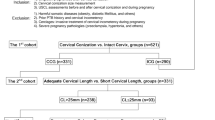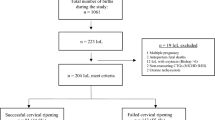Abstract
Objective:
To investigate the relationship between cervical length (CL) at 37 to 40 weeks and delivery within 7 days and delivery by 41 weeks.
Study design:
We performed transvaginal ultrasound to measure CL in women with singleton gestations at 37 to 40 weeks. We then used a receiver operating characteristic curve (ROC) to assess the relationship between CL and delivery within 7 days and delivery by 41 weeks.
Result:
For the 120 women included in the analysis, the mean CL (±s.d.) was 25.3±9.8 mm. The logistic regression model to predict each of the outcomes includes gestational age at ultrasound (GA-US) and CL. Neither birthweight, nor parity seems to affect the probability of delivery within 7 days. The ROC curve was used to assess the probability of spontaneous labor within 7 days at each CL measurement. The likelihood ratio of delivery within 7 days when CL is ⩽10 mm is 12.
Conclusion:
CL measurement at 37–40 weeks is an independent predictor of delivery within 7 days and delivery by 41 weeks regardless of GA-US. This information can be utilized when counseling patients regarding the management of term pregnancies.
This is a preview of subscription content, access via your institution
Access options
Subscribe to this journal
Receive 12 print issues and online access
$259.00 per year
only $21.58 per issue
Buy this article
- Purchase on Springer Link
- Instant access to full article PDF
Prices may be subject to local taxes which are calculated during checkout


Similar content being viewed by others
References
Bernstine RL, Sung HL, Crawford WI, Shimek MP . Sonographic evaluation of the incompetent cervix. J Clin Ultrasound 1981; 9: 417–420.
Iams JD, Paraskos J, Landon MB, Teteris JN, Johnson FF . Clinical sonography in preterm labor. Obstet Gynecol 1994; 84: 40–46.
Iams JD, Goldenberg RL, Meis PJ, Mercer BM, Moawad A, Das A et al. The length of the cervix and the risk of spontaneous delivery. N Engl J Med 1996; 334: 567–572.
Ware V, Raynor BD . Transvaginal ultrasonographic cervical measurement as a predictor of successful labor induction. Am J Obstet Gynecol 2000; 1882: 1030–1032.
Boozarjomhri F, Timor-Tritsch I, Chao CR, Fox HE . Transvaginal ultrasonographic evaluation of the cervix before labor: presence of cervical wedging is associated with shorter duration of induced labor. Am J Obstet Gynecol 1994; 171: 1081–1087.
Reis FM, Gervasi MT, Florio P, Bracalente G, Fadalti M, Servi FM et al. Prediction of successful induction of labor at term: role of clinical history, digital examination, ultrasound assessment of the cervix and fetal fibronectin assay. Am J Obstet Gynecol 2003; 189: 1361–1367.
Rane SM, Guirgis RR, Higgins B, Nicolaides KH . Models for the prediction of successful induction of labor based on pre-induction sonographic measurement of cervical length. J Matern Fetal Neonatal Med 2005; 17: 315–322.
Vimercati A, Greco P, Lopalco P, Loizzi V, Scioscia M, Mei L et al. The value of ultrasonographic examination of the uterine cervix in predicting post-term pregnancy. J Perinat Med 2001; 29: 317–321.
Ramanathan G, Yu C, Osei E, Nicolaides KH . Ultrasound examination at 37 weeks' gestation in the prediction of pregnancy outcome: the value of cervical assessment. Ultrasound Obstet Gynecol 2003; 22: 598–603.
Rozenberg P, Goffinet F, Hessabi M . Comparison of the Bishop score, ultrasonographically measured cervical length, and fetal fibronectin assay in predicting time until delivery and type of delivery at term. Am J Obstet Gynecol 2000; 182: 108–113.
Bayramoglu O, Arslan M, Yazici G, Erdem A, Erdem M, Bayramoglu K et al. Prediction of spontaneous onset of labor at term: the role of cervical length measurement and funneling of internal os detected by transvaginal ultrasonography. Am J Perinatol 2005; 22: 35–39.
Acknowledgements
This study is funded by the American College of Obstetricians and Gynecologists, District IV 2001 Special Award and presented in part at the Annual Clinical Meeting of American College of Obstetricians and Gynecologists in 2002.
Author information
Authors and Affiliations
Corresponding author
Rights and permissions
About this article
Cite this article
Tolaymat, L., Gonzalez-Quintero, V., Sanchez-Ramos, L. et al. Cervical length and the risk of spontaneous labor at term. J Perinatol 27, 749–753 (2007). https://doi.org/10.1038/sj.jp.7211819
Received:
Revised:
Accepted:
Published:
Issue Date:
DOI: https://doi.org/10.1038/sj.jp.7211819
Keywords
This article is cited by
-
Does third trimester cervical length predict duration of first stage of labor?
Wiener klinische Wochenschrift (2019)



